
Self guided tour of the Eagle’s Nest
Discover what most visitors miss during their to trip to the Eagle’s Nest with our detailed step by step tour.
From the breathtaking Eagle’s Nest road and its 5 tunnels to the original brass-lined lift (elevator) hewn into the mountain, use our step by step guide to find out what awaits you on your visit to the Eagle’s Nest.
- 1. The ticket desk
- 2. The Eagle’s Nest Road
- 3. Securing your return bus journey
- 4. The entrance portal
- 5. The entrance tunnel
- 6. The lift (elevator) in the mountain
- 7. The entrance hall
- 8. The dining room
- 9. The great hall
- 10. Eva Braun’s tea room (Scharitzkehl Zimmer)
- 11. The sun terrace
- 12. The kitchen
- 13. Hitler’s study
- 14. The guard’s room
- 15. Bedrooms
- 16. Your return journey from the Eagle’s Nest
1. The ticket desk
The Eagle’s Nest is served by its own special bus route, although you can also walk up from Berchtesgaden town (4-5 hours) and the main Obersalzberg car park (2-3 hours). See our tips above for further information about walking to the Eagle’s Nest.
If you’re going to take the special bus service, then prepare yourself for an unforgettable 15 minutes of breath-taking views.
Once you’ve arrived at the main car park (see our tips above for the address), the Eagle’s Nest bus departure point is clearly marked with large blue flags with “Kehlsteinhaus” written on them. Head down the steps by the blue flags and you’ll see the ticket office and bus stops.
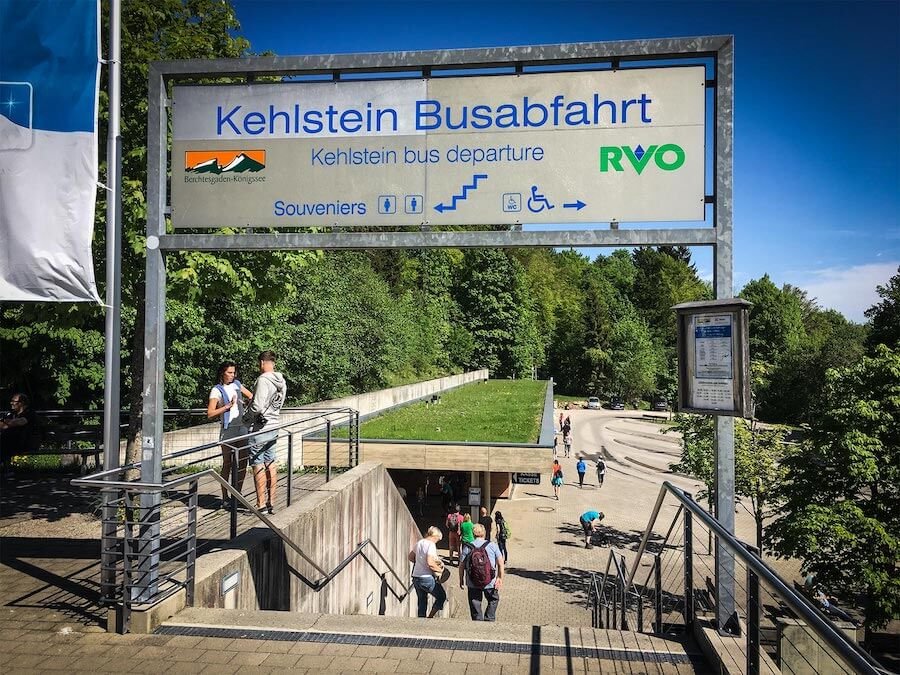
You must buy your tickets from the ticket desk and they will assign you to a particular departure time and bus number. Busses leave every 25 minutes and the schedule begins at 0830 every day of the week.
There’s an excellent model of the former Obersalzberg at the bus departure point gift shop, so if you’ve some spare time it’s worth taking a look.
2. The Eagle’s Nest Road
The route you’re about to ascend was only opened up to the public in 1952, some 7 years after the end of the Second World War and 14 years after its construction. Between opening in 1938 and the end of the war in 1945, various types of vehicle made their way up the 6.5km (4 miles) main route to the Eagle’s Nest, from convertible Volkswagens to armoured Mercedes. From 1945 to 1952, it was the reserve of sightseers from the occupying Allied forces, whose preferred mode of transport was the Willys/Ford Jeep.
Since 1952 this private road has only been open to specially adapted Mercedes/MAN busses of the regional bus operator Oberbayernbus. The current fleet all feature extremely torquey supercharged diesel engines to pull you up the 800m or so of elevation. They also have specially-engineered engine braking systems for the return journey back down the steep 27% grade mountain route.
Each spring, the rock faces all along the route are checked and all the loose rocks that are dislodged over the winter months are made safe or removed. This routine, coupled with thorough training and testing of the bus drivers, explains the perfect safety record the Eagle’s Nest bus route boasts – not bad considering that some 400,000 visitors make the journey each year.
As the bus sets off, you’ll have a good view of the five-star hotel built on the site where Bormann and Göring formerly had their homes on the Obersalzberg. The large open space to your immediate left with the mountain bike / Segway track was in fact the site of the SS barracks, this large open space forming a central parade ground.
Soon the ascent begins with gusto as the bus takes you over the only bridge of the entire Eagle’s Nest road before winding through the forest where you’ll see one of the water pumping stations that once supplied water collected from the Kehlstein mountain to the Obersalzberg.
As the trees thin, you’ll begin to see the grand view north that the road affords of the Untersberg mountain range and Salzburg in the distance, to the right-hand side of the Untersberg. On a particularly clear day, you may even be able to make out the cream walls of the Salzburg fortress.
It’ll no doubt have struck you that this road is in fact a single carriageway, so how do the busses returning from the Eagle’s Nest pass those coming up from the bus departure point? The answer lies around the next corner before the first tunnel: exquisite timing and passing points. When the busses leave from the ticket office area, so too do the busses that have been picking up visitors at the Eagle’s Nest. The drivers are in constant communication with each other and meet exactly half way, where those coming up the mountain have priority and those coming down make use of the passing points.
After the passing point comes the first of five tunnels along the road, the Hochlenzer Tunnel. This tunnel is the longest on the route at 150m (500ft) and once you emerge from it, you’ll be facing west into the Berchtesgaden National Park. From this side of the mountain a magnificent panorama unfolds with lake Königssee in the distance flanked by the Watzmann mountain to the right and the mountains Jenner, Hohes Brett and Hoher Göll to the left. The Watzmann is Germany’s second highest mountain at 2713m (9000ft) but it is fondly thought of as the highest mountain entirely in Germany, since the Zugspitze (officially Germany’s highest mountain) straddles both Germany & Austria.
Heading further around to the south face of the mountain, the ascent continues. Looking down into the valley below, there’s no hiding from the 400m drop down to the Scharitzkehlalm pasture. This is one of the most shaded mountain pastures (alms) in the region and it’s not uncommon to see people cross country skiing here until mid/late spring.
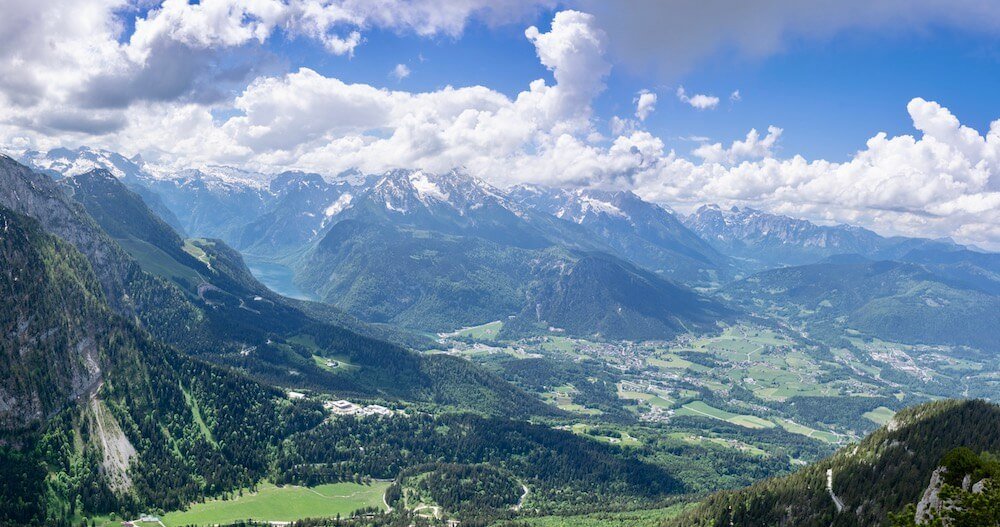
Just after the shortest tunnel on the road, the Martinswand tunnel (30m, 1000ft) comes the one and only hairpin turn on the entire road, where the Hoher Göll mountain basin provides a jaw-dropping panorama. This basin is a favourite amongst climbers who make use of the many routes up to the 2,522 m (8,274 ft) peak from the Scharitzkehlalm pasture below.
The hairpin was also the intended site for the tunnel leading into the mountain and lift (elevator) up to the Eagle’s Nest. You may catch sight of some steps and a wooden hut on the north side of the hairpin; it was in this direction that a 30m (100ft) test tunnel was dug and hit unstable rock. It was decided to continue the road back along the south face of the Kehlstein and wind around to the north face so that a more suitable tunnel location could be found. As a result, you now have another three tunnels to enjoy before you reach the drop-off point at the Eagle’s Nest:
Zigeunertunnel (12m, 40ft)
Südwandtunnel (65m, 215ft)
Schwalbennesttunnel (20m, 65ft)
3. Securing your return bus journey
As you step off the bus, the staff of the Eagle’s Nest (typically wearing blue polo shirts) will instruct you (in German) to queue up and have your ticket stamped with a desired return bus journey time. The queue line forms alongside the refreshment kiosk and is secured with a rope-barrier to keep guests away from turning busses.
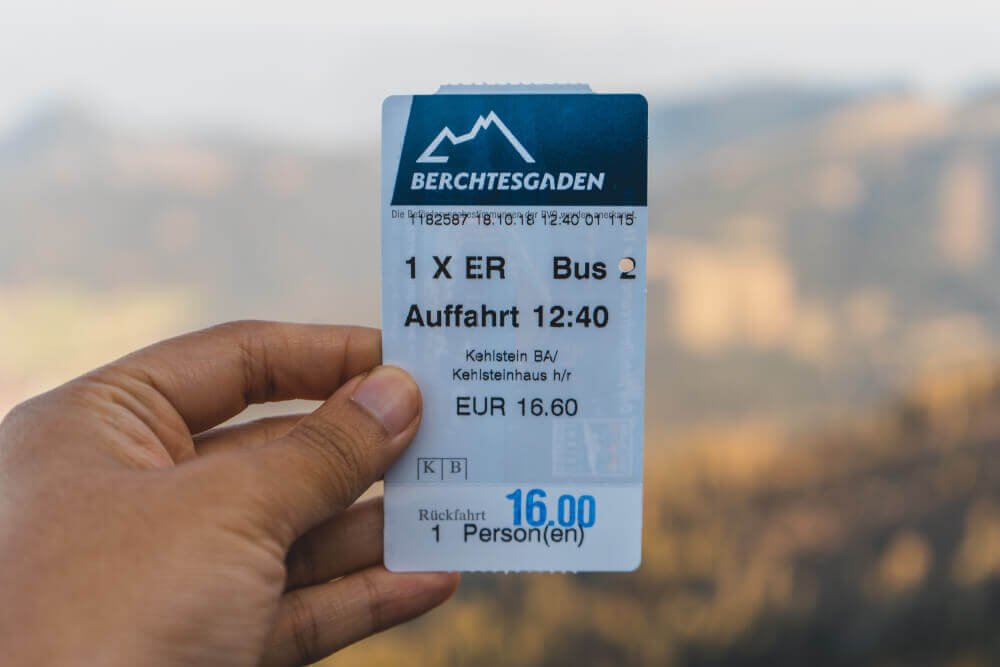
Having your ticket stamped as soon as possible is a must. It’s worth remembering that there’s a fixed timetable and a finite number of busses, so it’s important to choose your return journey time carefully and to reserve it ASAP. We recommend to spend at least two hours at the Eagle’s Nest, more if it’s a sunny day and you’d like to make use of the sun terrace to have something to eat.
Once you’re at the front of the line by the staff kiosk, present your ticket to the clerk and tell them your required return time. They’ll then stamp your ticket and your place on the return leg will be reserved.
4. The entrance portal
After you’ve had your bus ticket stamped with a return time, you’ll be face to face with the towering bronze double doors that guard the lift access tunnel during winter. Closed as the first snows fall in early winter, these doors are only re-opened once vehicles can ascend the eagle’s nest road safely the following spring.
Were we stood here in September 1938, all that would have hinted at the engineering hidden inside the mountain were the bronze entrance portal doors. The buildings to the left and right of the entrance portal are not original but in fact post-war add-ons, deemed necessary for the conversion into a tourist restaurant in 1952.
There is one exception: the original entrance door to the utility tunnel, some 50 meters to the right of the main entrance portal. Whilst the Eagle’s Nest has always drawn its power via an underground cable from the Berchtesgaden valley, there has always been a backup generator in a cavern on the other side of this door: an original 1938 MAN U-Boat diesel engine. This is still running today complete with its annual TÜV safety certificate. The rather man-made rock formation above the utility tunnel door masks the exhaust stack of the 8-cylinder slumbering monster engine.
The text above the entrance to the tunnel alerts us to the completion of the original works in 1938 (The German word ‘erbaut’ means ‘completed’).
5. The entrance tunnel
Stretching out ahead of you is the 124m long tunnel leading directly into the mountain. At the end of the tunnel, a waiting chamber at the foot of the lift shaft awaits. You’ll notice the original light fittings directly overhead stretching into the tunnel; both they and all of the blockwork you see around you are exactly as was found in 1938 when this tunnel was used to shuttle visitors to the waiting chamber by car.
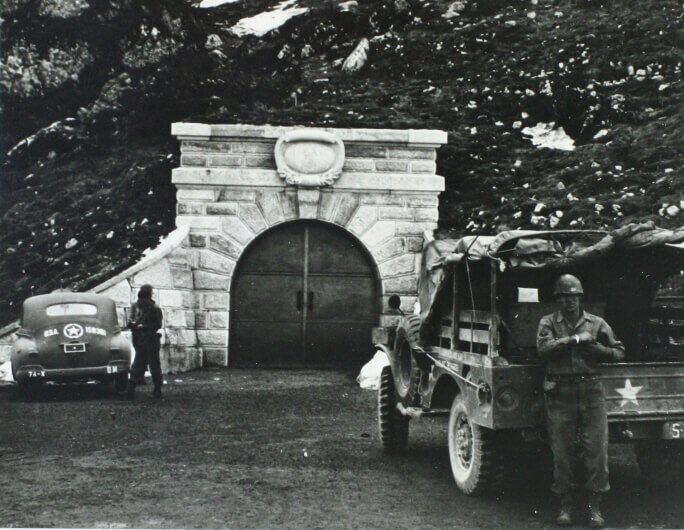
Entering through the first set of bronze tunnel doors you’ll see one of four lift height indicators on your right-hand side – another can be found in the lift carriage behind the operator, with the final pair situated at the top and bottom of the lift shaft.
You’ll notice the names Otis and Flohr stamped on the visible lift components; all hardware for the lift was manufactured by German firm Flohr in 1938 and those bearing the Flohr name are original items from the period. After the war, Flohr was acquired by US firm Otis, who still service the system today and mark all replacement components with their name instead.
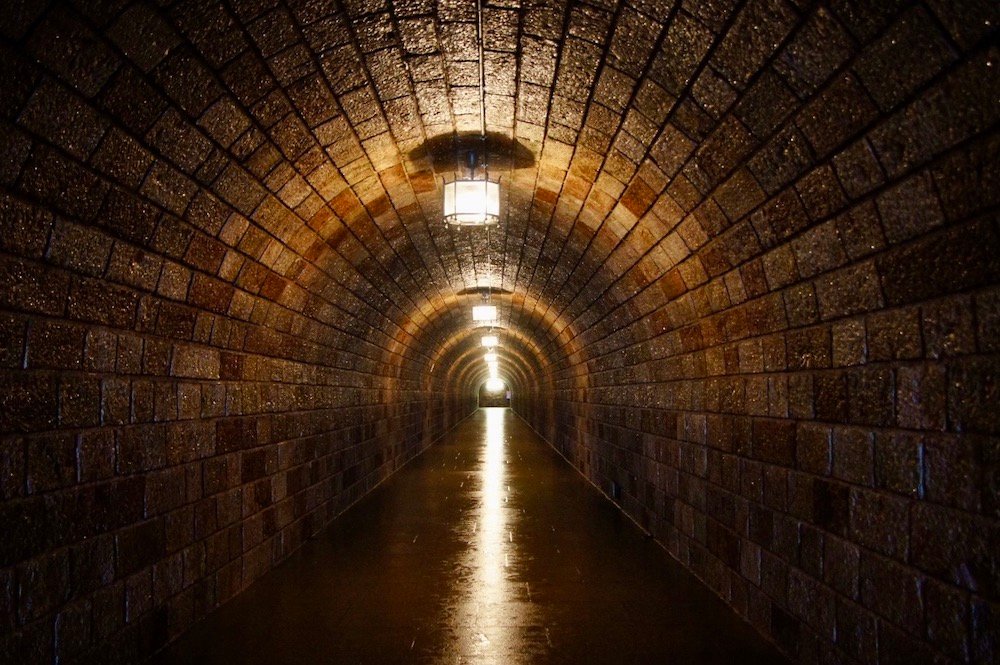
Making the journey into the mountain in 1938, you’d have had a much warmer journey thanks to an air heating system that utilised the air vents you can see to your lower right-hand side as you walk along the tunnel.
At the end of the tunnel you’ll see a non-original neon strip light marking a nook, seemingly without purpose. This area was, believe it or not, once the drinks storage area for the restaurant in the Eagle’s Nest. Being the furthest point within the mountain, it held a constant cool temperature all summer long – perfect for storing crates of beer. The true origin of this area lies in the fact that the stone masons working on the project took it upon themselves to create a lop-sided swastika by laying lighter colour blocks of marble at the end of the tunnel. Anecdotes tell us that Bormann was not pleased and had a brass door fitted to cover up the niche.
6. The lift (elevator) in the mountain
Turning right at the end of the tunnel you’ll find the lift waiting chamber. The domed ceiling and circular walls create a solid marble cavern where guards would have originally flanked the brass panelled doors covering the entrance to the lift shaft.
For those visiting the eagle’s nest this was the first real taste of the architectural style used to embody the idea that the National Socialist regime’s third kingdom (third Reich) would last the promised thousand years.
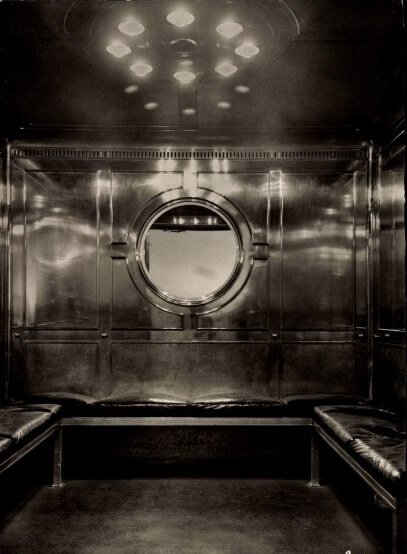
After a short wait in the lift antechamber, you’ll have the opportunity to board the original brass-lined lift carriage that takes you up the final 124 meters (406 feet) up into the Eagle’s Nest. Although the lift carriage itself is original, the winding mechanisms and motors were replaced in 1973 with the current winding gear that gets you to the top in just under 60 seconds.
Looking closely, you’ll see the Flohr markings on the lift height indicator within the lift carriage itself, showing us that this is the original indicator from 1938. It’s not just the height indicator in the lift carriage that’s original either; the period telephone, a clock that was standard fit to U-boats of the time and even the venetian mirror on the back wall are all the 1938 originals.
Today members of the Eagle’s Nest staff take it in turn to operate the lift throughout the day, whilst from 1938 to 1945 it was the job of one man, Georg Mehr. When boarding the lift, they will invite you to “aufrücken bitte” – squeeze in please. If it’s a quiet day and you ask very nicely, they might just let you ride up and down a couple of times.
A word of caution: due to the high reflectivity of the brass lining and venetian mirror, flash photography is strictly forbidden in the lift carriage.
In case of emergency there is a backup “Halimag” lift with capacity for three people running independently to the side of the main lift. It’s accessible through a hatch in the main lift carriage, or alternatively, you can make use of the original abseiling eyelet located at the upper left of the lift cabin and the trapdoor in the lift floor…

All things being well(!), in just 60 seconds or so you’ll be up at the Eagle’s Nest. When exiting the lift please be patient as it can take some time to get all 20-30 passengers safely into the compact entrance hall of the Eagle’s Nest.
7. The entrance hall
Stepping out of the lift you’ll see the queue for the return journey to your left and the toilets straight ahead. This area can often become quite congested and it’s best to take a swift right-hand turn towards the dining room.
Under your feet are original flagstones, complete with under floor heating system. Although not in use today, upon completion of the Eagle’s Nest in 1938 this system heated many of the rooms in the building and helps explain the lack of traditional radiators.
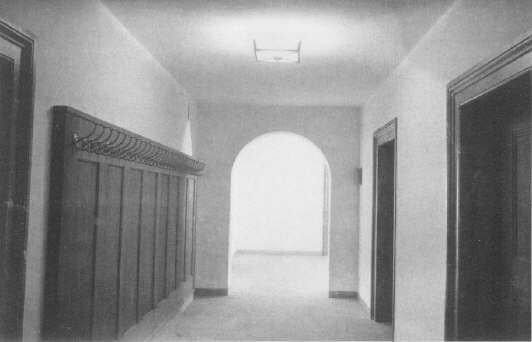
Please ensure you do not go any further than the toilets as this area, as the far hallway is the main thoroughfare for members of staff to access the kitchen from the rear terrace. Fast moving serving staff carrying hot food present quite a hazard to young children.
8. The dining room
Although now dominated by the open bar/kitchen at one end, this room was originally a formal banqueting hall. The oak panelling you can see on the walls and ceiling is the genuine article, however, that is really all that remains of the original dining room.
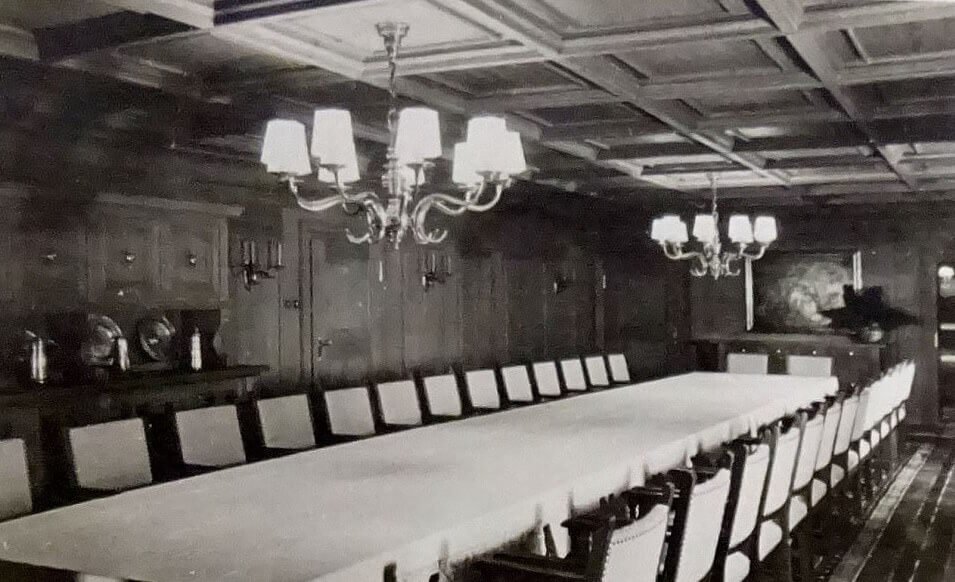
Had we entered this space in 1938, we would have been greeted by a gigantic long table, spanning the length of the room and offering seating for up to 26 people. Luxurious carpeting on the floor and large chandeliers hanging over the dining table would have added to the grandeur of this room, with an access door at the far end into Hitler’s private study. This was another taste of the interior architectural style used to embody the idea that the National Socialist regime’s third kingdom (Reich) would last the promised thousand years.
On the opposite side of the room to the entrance door, you’ll see a rank of windows that look out onto the sun terrace and hint at the two levels the Eagle’s Nest spans.
9. The great hall
Whilst initially conceived by Martin Bormann as a tea house, Eagle’s Nest found its main use as an entertaining space for VIPs and foreign diplomats visiting the Obersalzberg.
The architectural features and furnishings of this space were designed to convey a sense of grandeur and timeless power, a message that fitted well with Hitler’s vision of creating a new empire that would mimic those of Charlemagne and Bismark before him.
With this in mind, it’s easy to appreciate that the Great Hall is something of a stage, designed not only to convey the idea of a hall befitting the new thousand-year kingdom, but, with its thick granite-clad walls, huge oak ceiling beams and imposing red marble fireplace, a space to impress and intimidate visitors.
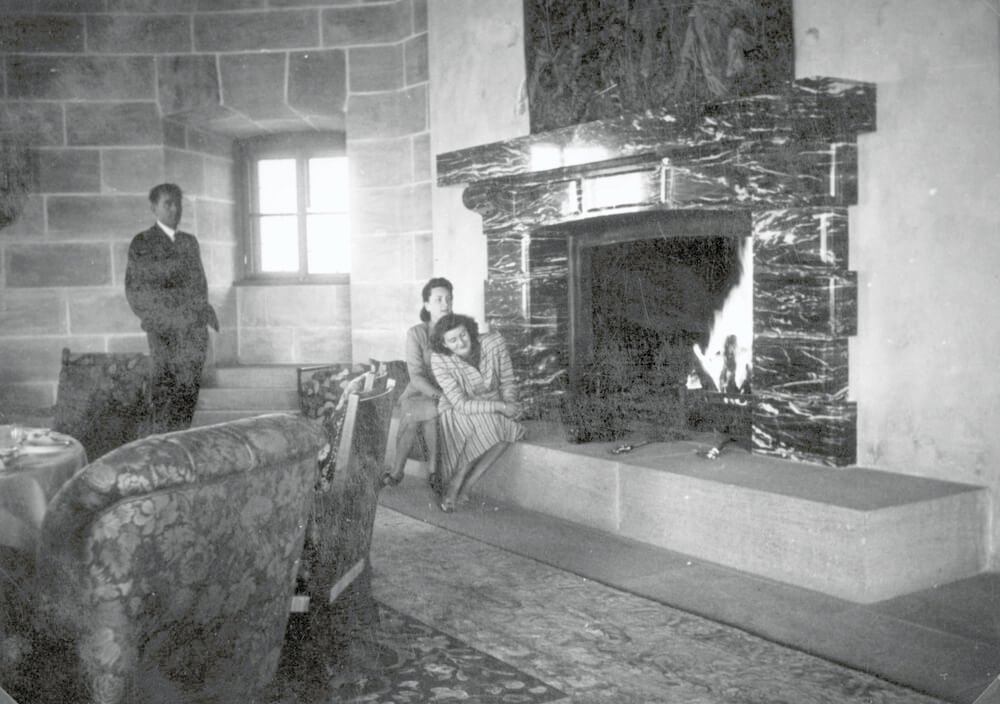
Stepping across the Great Hall in 1938 you would have sunk into the lavish 600kg (1300 lbs) carpet, on top of which was the large circular conference table with seating for around a dozen guests.
Once in the centre of the hall, the five windows offer an unforgettable alpine panorama with views to Salzburg on one hand and the alpine landscape of the Berchtesgadenerland National Park on the other.
Turning to face the red marble fireplace you’ll see that it’s been battered and bruised. This once superb example of craftsmanship was the focal point of the Great Hall, but its appearance today is thanks to the fact that it also caught the eye of many allied troops who occupied the area from early May 1945.
Before allied commanders could place a guard on the building in the days following the occupation of Berchtesgaden and the Obersalzberg, occupying troops had made off with everything that wasn’t nailed down – including a pair of 16th century Goeblin tapestries, one of which hung over the red marble fireplace here in the Great Hall. The pair had been bought at a cost of over €400,000 adjusted for inflation.
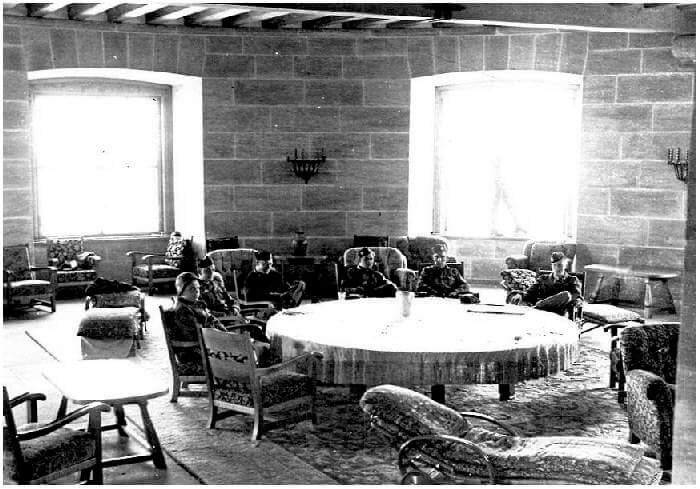
For those occupying soldiers somewhat late to the game, all that remained was the opportunity to chip off a piece of the famous red marble fireplace. If you look at the surface of the marble and catch the light at just the right angle, you’ll see a variety of inscriptions from the post-war occupation.
The Great Hall is also home to a number of myths and legends surrounding the Eagle’s Nest. One such legend is that the entire project was a gift to mark the occasion of Hitler’s 50th birthday. The fact that Martin Bormann retained ownership of the building until the end of the war and the completion date of September 1938, some seven months before Hitler’s 50th birthday, bring this theory into question. Perhaps Hitler’s 50th birthday (20th April 1939) was simply a useful and inescapable deadline?
Legend also has it that the red marble fireplace was a gift from Italian ally Benito Mussolini, also to mark Hitler’s 50th birthday. Supposedly, the Japanese emperor Hirohito followed suit by gifting the ornate carpet that lined the Great Hall. Such claims are best taken with a pinch of salt, since no firm evidence has been put forward to support them. It is often remarked how similar the supposed red Italian Carrara marble of the fireplace is to local red Untersberg marble.
Hitler visited the Great Hall for the first time in September 1938 and for the last time in mid-1940, when he hosted Crown Princess Marie-José, sister of King Leopold III of Belgium. Despite spending over a third of his time between 1939 and 1945 on the Obersalzberg, Hitler only recorded 14 official visits to the Eagle’s Nest.
A story that demonstrates the main users of the Eagle’s Nest is that which took place on the 3rd June 1944. Whilst the European and Pacific theatres were plunged deep into total war, the Eagle’s Nest hosted a wedding reception. After a service in Salzburg the sister of Eva Braun, Gretl Braun, held her wedding breakfast and evening reception in the Great Hall of the Eagle’s Nest at 1804m (4006ft).
It was thanks to her frequent use of the Eagle’s Nest and relationship with Hitler that Eva Braun could organise this event to mark the marriage of her sister and SS officer Hermann Fegelin of Heinrich Himmler’s staff. Martin Bormann was, as always, in attendance to oversee the proceedings.
10. Eva Braun’s tea room (Scharitzkehl Zimmer)
This room is often referred to as Eva Braun’s tea room owing to the fact that she enjoyed using this cosy parlour with friends on private visits to the Eagle’s Nest. The room’s proper name is the ‘Scharitzkehlstube’, which translates to “the parlour above the mountain pasture Scharitzkehlalm” – this is the pasture you can see well from the Eagle’s Nest road hairpin turn.
Stepping down into this room in 1938 you would have been greeted by the same impressive views over to the Watzmann mountain, lake Königssee and the Hoher Göll mountain that you see today. At the time you could have gone a step further and retracted the windows down into the wall, a party piece of the original windows in this room and the Great Hall.
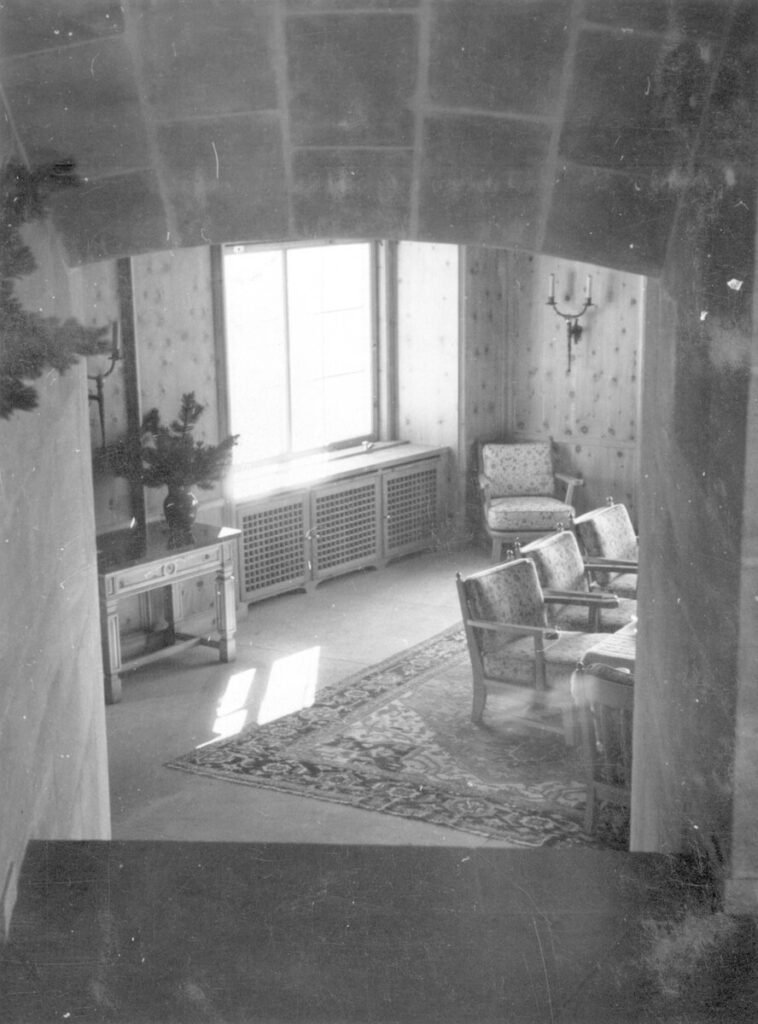
Stepping down into this room in 1938 you would have been greeted by the same impressive views over to the Watzmann mountain, lake Königssee and the Hoher Göll mountain that you see today. At the time you could have gone a step further and retracted the windows down into the wall, a party piece of the original windows in this room and the Great Hall.
Pride of place in the Scharitzkehlstube was the opulent 16th century tapestry from the Parisian firm Gobelin, depicting a medieval hunting scene that overlooked the friendly arrangement of table and informal chairs.
Aside from the pine wall and ceiling panelling, nearly all of the fixtures and fitting from the room are today unaccounted for…with one exception: the Gobelin tapestry.
Bought at a cost of 24,000 Reichsmarks in 1938, a sum equivalent to around €100,000 adjusted for inflation, it vanished in 1945 and only re-surfaced again in 2016, when the daughter of an American 101st Airborne division intelligence officer decided to return one of her late father’s war mementoes.
The tapestry had hung in the family’s Minneapolis home for decades and is due to be displayed in the Bavarian National museum in Munich after restoration. Since it was bought at market value in 1938 and not considered a distressed purchase, ownership passed to the state of Bavaria at the conclusion of the war.
11. The sun terrace
Heading out through the side door of Eva Braun’s Tearoom (Scharitzkehl parlour) we pass onto the sun terrace. If you look behind you, the original bronze double gates are still present on either side of the entrance way to the Eva Braun’s tearoom.
High on the left-hand side of the sun terrace you will see the windows of the dining room and now gain a good perspective of the two levels of the Eagle’s Nest. The purpose of the lower level is the same today as is was in 1938: it contains the supplies and infrastructure to support the formal rooms above.
On the right-hand side of the terrace, you will see the giant granite-block arches that flood this area with sunlight. Originally these archways were open, however, with the opening of the building to the public in 1952, it was decided to enclose them with glass on the grounds of safety.
A new floor covering today covers the original flagstones from 1938, and you’ll notice that the boot scraper next to the entrance door to the lower level of the building has been swallowed up by the new floor covering.
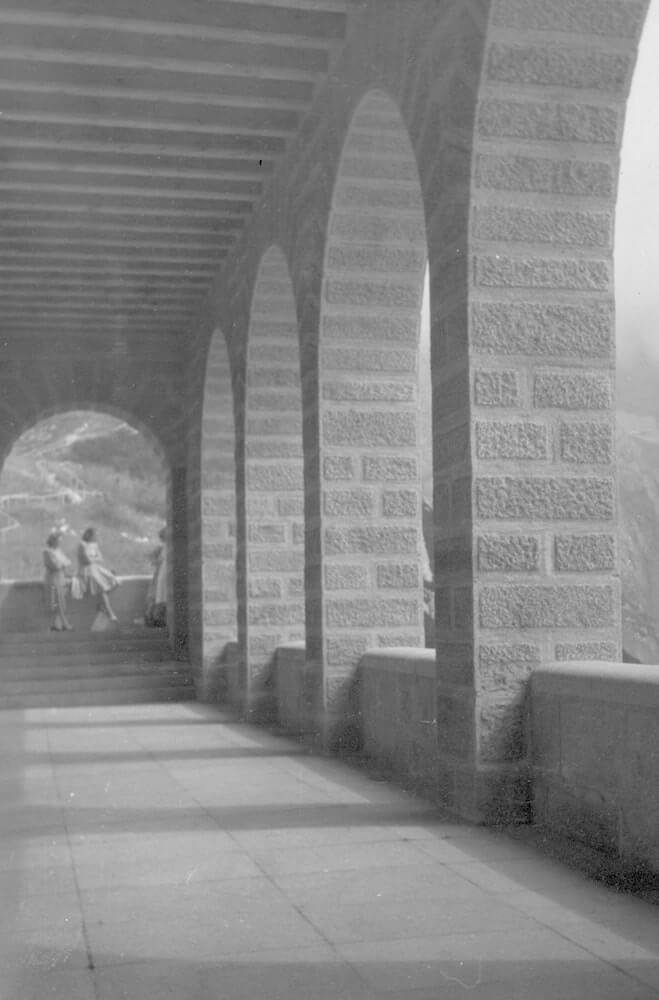
If you’ve seen the HBO series Band of Brothers, the sun terrace and great hall feature in the final episode “Points”, where members of Easy Company of the 101st Airborne visit Berchtesgaden, the Obersalzberg, Göring’s house (wine cellar) and the Eagle’s Nest. What most don’t realise, however, is that the Eagle’s Nest in the series was a mock-up built at Pinewood studios in South England – albeit a pretty good replica.
An exhibition including some rare photographs and in-depth commentary on the Eagle’s Nest is situated in the sun terrace and well worth a look if you have the time.
12. The kitchen
If you are able to glimpse into the doorway around half way along the sun terrace, you’ll see the kitchen that today prepares snacks and meals for the Eagle’s Nest restaurant.
Despite the building offering no overnight accommodation, it has always had kitchen facilities. In 1938 the kitchen was equipped with the most modern equipment and opulent sets of silver cutlery and porcelain crockery, although it was never required to carry out anything more than light duties.
All cutlery and some crockery bore “AH” initialled motifs and were viewed as prize war mementoes by allied soldiers as soon as they started visiting in May 1945.
13. Hitler’s study
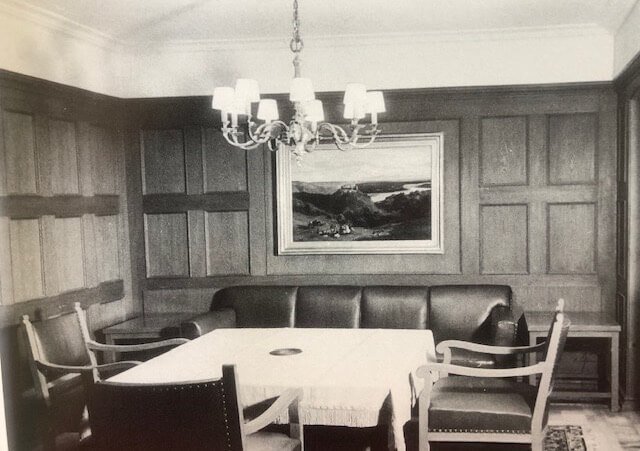
Although finished to extremely high standards and well equipped, the study in the Eagle’s Nest was never actually used by Hitler. The presence of a study in the original layout of the building suggests that it was designed as a space not just for entertaining, but also for receiving guests on more official business. Hence in German the building was often referred to as the D-Haus, the Diplomatic House. Indeed, one of earliest visitors to the newly completed Eagle’s Nest was the french ambassador to Germany Andre Francois-Poncet. It was he, in in October 1938, who first coined the name ‘Eagle’s Nest’ for the building.
Since 1952 the study has been re-purposed as the restaurant manager’s office and is strictly off-limits to visitors.
14. The guard’s room
As part of the security measures put in place on the Obersalzberg, a 10 km (6 mile) security wall was built around the Kehlstein mountain area to be patrolled by SS guards. These guards would use this room during their downtime and sometimes even stay overnight.
Today the guard’s room is often used as an overflow area for the seated restaurant service, especially if the weather is particularly bad.
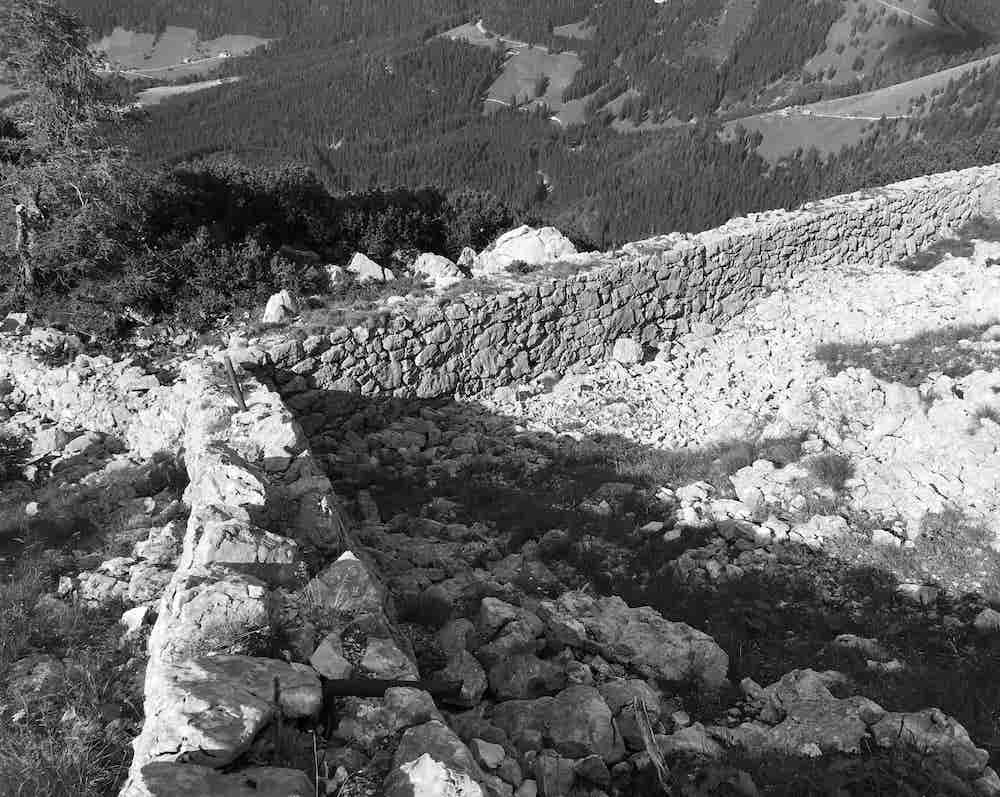
15. Bedrooms
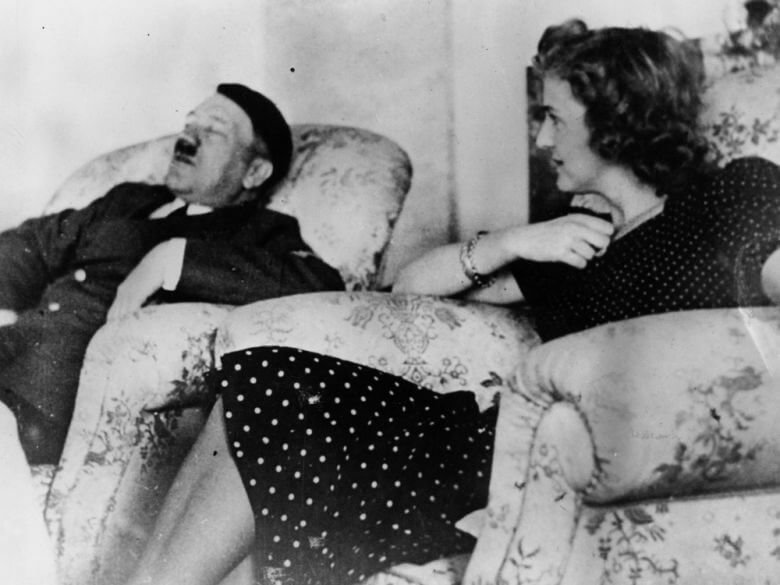
The Eagle’s Nest was built by the National Socialist regime to function primarily as a day house for entertaining foreign diplomats.
To this end no bedrooms were ever planned or completed, although in the 1970s, whilst functioning as a restaurant, the basement area underneath the Great Hall did in fact serve as overnight quarters for some of the restaurant staff.
16. Your return journey from the Eagle’s Nest
It’s important to leave yourself plenty of time to get back down to the bus departure point 10 minutes ahead of your allotted return journey, since the queue for the lift back down can often take a good 15 minutes to clear on busy summer afternoons.
One highly recommended alternative is the walk back down to the bus departure point, taking in several breath-taking views over the Berchtesgadenerland National Park and the Berchtesgaden Valley as well. This route will take you around 40 minutes but is well worth it and a pleasant alternative to standing in line waiting for the lift on a busy summer’s day.
From the terrace at the rear of the Eagle’s Nest, head to the right-hand side of the building, past the lift queue and down the steps towards the front of the building. You’ll see a yellow sign post giving direction and an estimated time to the bus departure point. This route down also offers an impressive view of the Great Hall exterior and is a great photo opportunity that most miss.

The mixed asphalt/gravel path then snakes down the mountain and once you reach the bottom, you’ll need to walk along the main Eagle’s Nest road for around 200m (650ft) – watch out for the busses coming up the mountain. This route was one of the original worker’s routes used during construction of the Eagle’s Nest and the route that those sightseers who weren’t officers or higher had to take when sightseeing during the US occupation of the area.

It also gives you a chance to look for the service tunnel entrance door and emergency generator (MAN U-boat engine) exhaust stack on your right-hand side just before the refreshment kiosk.
Back at the departure point you’ll be able to board any of the assembled red busses at your allotted return time, just show the driver your ticket stub with the return time stamp and you’ll be shown on-board. If you have lost your ticket or missed your return time, head over to the ticket kiosk and explain the situation to one of the staff there – they’ll be able to squeeze you on to the next bus with spare capacity.

